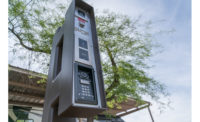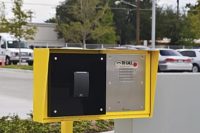The term “entry control” can be confusing to some; but it doesn’t have to be, says Mike Busby, marketing and sales manager for Viking Electronics Inc., Hudson, Wis. “‘Entry controls’ doesn’t need to be confusing — it comes down to letting the good things in and keeping the bad things out. How you make that happen has endless possibilities, from a single keyed lock all the way to biometric access with 24/7 video surveillance.”
Entry control systems are different from access control systems in that they are typically used for those who are not employees or someone that would be given a regular credential. Thus, they usually have an intercom or call system, combined with a barrier or locked door.
“An entry control system starts with a barrier, typically a door or gate that’s kept locked,” explains Paul Hefty, technical sales and support engineer II, Aiphone Corp., Redmond, Wash. “The next part of the equation is an intercom that enables visitors to let facility staff know they’re at the entry … The final part of the equation is the electric door strike or gate operator. Once the visitor is identified, staff can open the barrier via the intercom.”
While the general premise is fairly straightforward, how you get there has changed in recent years, particularly with the advent of IP-based video, mobile credentials and wireless technology.
Powering the Future: 3 Ways Power Systems Overcome Integrators’ Challenges

With electronic access control systems becoming more sophisticated, it’s understandable that integrators are focusing on the latest technology in locks, intelligent keys and even biometric entry controls like fingerprinting and iris scans. Yet behind these solutions that keep openings secure is a component they can’t work without — power. And just as entry control technology is evolving to meet new challenges, so too are the power supplies that keep them going.
In fact, power is increasingly important to the entry control systems we use today, and the ones that we’ll use tomorrow. Interconnected systems are only as secure as each access point and as a result, power supplies must be both reliable and capable of overcoming pain points that integrators face when implementing entry control systems.
Here are three ways the right power solutions can address the needs of security integrators:
1. Meet the skills shortage — A recent study found 62 percent of firms are struggling to fill skilled positions in electrical, engineering and machining. As skilled technicians are harder to find, prefabricated enclosures can address this staffing issue since they’re easier to install and maintain. Standardized, prewired enclosures require less work in the field. It’s also easier to create troubleshooting guides and documentation because of their consistency. Prefabricated solutions are therefore more efficient for installers and technicians, whether they’re trained on other technologies or configurations, or if they’re apprentices learning the trade. Additionally, many manufacturers offer free or low-cost product installation training that can help get green technicians up to speed faster.
2. Increase customer satisfaction — Today’s power solutions also function as intelligent network devices. Managed power systems, such as LifeSafety Power’s ISCAN SmartPower systems, remotely monitor the locks and batteries that comprise entry control systems, and they notify security integrators of problems. This makes integrators aware of failing batteries so they can change them proactively, or it allows them to replace a faulty lock that is drawing too much power before it becomes a hazard.
Rather than call the security integrator when something has gone wrong, customers will gain trust when their integrator addresses a problem before it happens. And, managed power systems can provide customers with detailed reports on operating status, encouraging a relationship built on transparency.
3. Improve the bottom line — Managed power solutions help security integrators make trips into the field only when necessary. Instead of performing annual battery checks, these solutions notify integrators when batteries need maintenance, saving time and deployment costs. And, by informing them when an entry device may be failing, managed power solutions help integrators to schedule maintenance when they first see an issue developing, rather than reacting to a failure and potentially servicing those entries after hours.
Power systems should be top of mind as integrators install and maintain increasingly advanced entry control technologies. Not only does power keep the system functioning, it can address a variety of business challenges that integrators are facing and help drive their projects forward in the long-term. — Contributed by David Corbin, director of access control accessories, ASSA ABLOY Electromechanical Specialties
SDM spoke with Busby of Viking; Hefty from Aiphone; as well as David Price, marketing manager, Camden Door Controls, Mississauga, Canada; and Ewa Pigna, vice president, engineering, LenelS2, Pittsford, N.Y., for the latest on these solutions.
SDM: What do you see as the most recent trends in entry control?
Price: Wireless entry control is taking on tremendous traction. End users want the added convenience wireless delivers.
Hefty: Video intercom stations that have smartphone apps are becoming more popular due to the convenience they offer. Another trend we see is a demand for visual and voice guidance at the entry. With today’s DC-powered locks, visual and audible notification is a must-have. Systems need to guide the visitor through the process. Audible and visual cues let a visitor know that their entry request has been received and the door is open. Additional audible instructions during the door release help guide visitors to the check-in desk.
Pigna: On the access side of entry control, there are a couple of trends that LenelS2 is observing. We’re seeing more end users provision their users with mobile apps that provide frictionless, yet secure access to a facility as a means of gaining entry. With respect to equipment, we’re seeing more wireless locksets that provide low-cost, all-in-one solutions.
Busby: Entry control is constantly changing, evolving, and adapting to meet current requirements and standards. Today’s technology features VoIP protocol or converting existing analog products to be IP compatible. Many door entry solutions utilize keyless entry or card reader entry, as well as app/remote connectivity, 24/7 monitoring, identity verification, biometrics and more.
SDM: What role have new technologies such as mobile credentials, cloud, wireless, etc., played in the design or installation of entry control solutions?
Hefty: Network-based systems are taking the lead in all aspects of entry control. These systems allow for flexibility. A business can start small and then grow as needs change. Wireless and cloud-based systems allow people controlling the entry to multi-task, as they are no longer tied to a desk. Using an app, security guards and receptionists can monitor the front door while patrolling the outside building perimeter or participating in a meeting.
Busby: New technology has played a leading role in the development of entry control solutions. The use of mobile credentials has made security more convenient for both the installer and the user. Cloud and wireless options have allowed for affordable remote monitoring as data storage costs decrease year after year. Unfortunately, these conveniences have also opened the door for new kinds of security failures — instead of physically forcing a door open, doors can now be opened remotely, which may lead to bad things getting in — and that’s why it’s necessary to have extra levels of security in place.
Pigna: Today, new technologies are facilitating deployment, driving increased security and lowering operational costs. Therefore, there is an increase in penetration of security entry points across multiple verticals, such as education, commercial and hospitality. In addition, there is an increase in interoperability between various manufacturers of these new technologies, which simplifies deployment and long-term maintenance.
SDM: Do you have any new or recent products or developments we should know about?
Hefty: Our basic JO Series system now includes a smartphone app. We also added an adapter that expands the system to accommodate two-door stations. We are continuing to add components to our IX Series 2 system. We have recently added the IPW-1VC, a two-wire-to-Ethernet adapter. This allows us to replace older hardwired systems with the modern IX Series 2 system.
Pigna: LenelS2 is focused on securing the edge of the architecture, which includes readers, credentials and related connectivity. BlueDiamond readers support OSDP and virtual credentials following the latest security models. In addition, LenelS2 is expanding its product portfolio to include cloud-based services, such as notifications, access control and alarm monitoring. LenelS2 is also evolving its hardware with the introduction of the new access control blade, providing support for OSDP.
Busby: Over the past few years Viking has introduced a large selection of IP door entry systems, IP emergency phones and IP paging systems. We are in the last stages of testing our newest vandal-resistant IP HD Video Entry Phone — model X-35. We are also putting the final touches on our new compact IP HD Video Entry Phone —model X-205, which is designed to surface mount to a wall, post or single gang electrical box. Both of these IP HD Video Entry Phones feature dual-stream 1080P video, a built in 2-Amp relay, ONVIF compliance, and can be used with the mobile Viking app, available in iOS or Android.
Price: Camden recently introduced its newest offering — Kinetic by Camden. This 900 Mhz. ‘power harvesting’ wireless system uses the energy created by the operation of the switch to power the wireless transmitter. There are no batteries to maintain or replace and no hazardous waste entering landfill. Kinetic by Camden also features an ultra-compact receiver (easily installed in automatic door operator cabinets), with field-selectable momentary, delayed or latching relay operation.
More Online
For more on entry control visit SDM’s website, where you will find the following articles:
“Integration, Audio & Video Drive Intercom Advances”
www.SDMmag.com/integration-audio-video-drive-intercom-advances
“The Limitless Possibilities of IP-Based Entry Control & Emergency Stations”
www.SDMmag.com/the-limitless-possibilities-of-ip-based-entry-control-emergency-stations
“The State of the Access Control Market in 2019”









